Key takeaways:
- Environmental education fosters stewardship and critical thinking, empowering individuals to make responsible choices for the planet.
- Effective eco-events require clear communication, local partnerships, and engaging activities to resonate with participants and extend awareness beyond the event.
- Measuring impact through surveys and tangible outcomes helps inform future initiatives and encourages community engagement.
- Involving the community in planning and prioritizing sustainability in logistics enhances participation and promotes eco-friendly practices.

Understanding environmental education importance
Environmental education is crucial because it empowers individuals to understand the impact of their actions on the planet. I remember attending a workshop once where I learned about the massive effects of plastic pollution. It hit me hard to realize that a simple choice, like using a reusable bag, could contribute to reducing waste.
When I think about how environmental education fosters stewardship, I reflect on a community garden project I participated in. Collaborating with others to cultivate plants not only deepened my connection to nature but also ignited a passion for sustainability. Isn’t it fascinating how hands-on experiences can shift our perspectives and inspire change?
Moreover, the importance of environmental education lies in its ability to develop critical thinking skills. In discussions about climate change, I often encounter diverse viewpoints that challenge my understanding. This dialogue fosters a sense of collective responsibility, and it begs the question: how can we not act when we know the stakes?
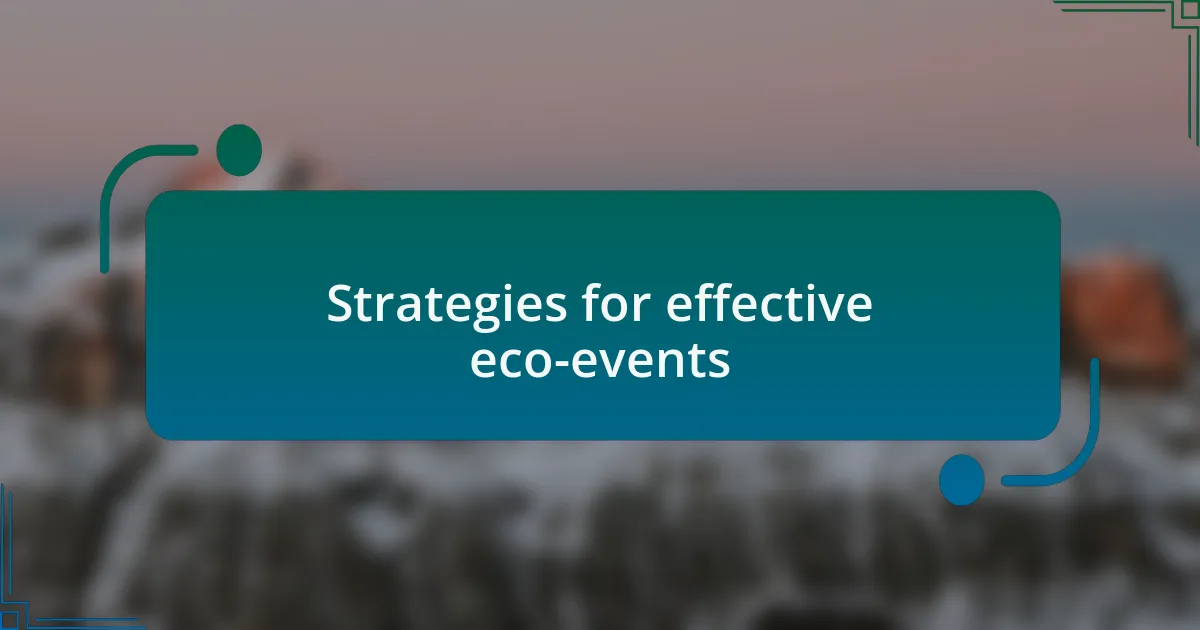
Strategies for effective eco-events
When organizing eco-events, one of my go-to strategies is to prioritize local partnerships. Working with local businesses and organizations not only enriches the event but also fosters community engagement. I once teamed up with a nearby farm for a sustainability fair, and it was inspiring to see how their participation brought authenticity and enthusiasm to the entire experience.
Another crucial aspect is creating interactive activities that resonate with participants. I vividly recall when I hosted a workshop focused on upcycling materials. Attendees created art from discarded items, and the joy on their faces as they transformed trash into treasures was priceless. This hands-on approach not only educates but also empowers individuals to think creatively about waste reduction.
Lastly, incorporating storytelling can significantly enhance the impact of eco-events. Sharing compelling narratives about local environmental issues can resonate deeply with participants. I’ve found that when I share my personal journey toward sustainability, it encourages others to reflect on their own habits and consider small changes. Isn’t it amazing how a story can spark a movement?
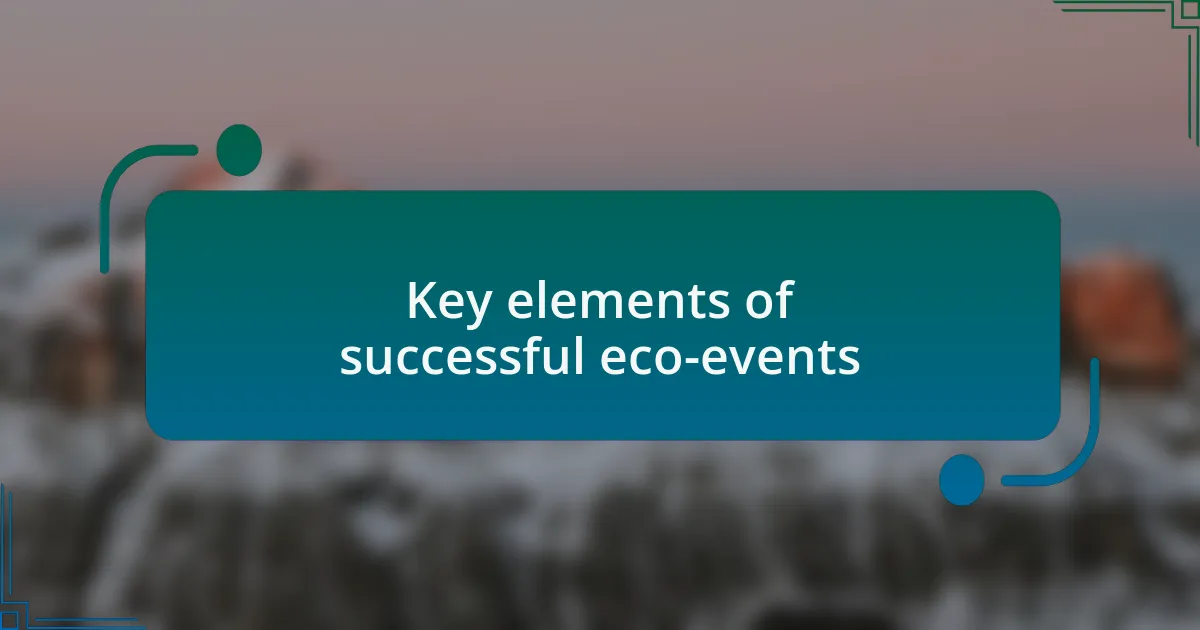
Key elements of successful eco-events
One key element of successful eco-events is effective communication of the event’s purpose. I remember a community clean-up I organized where I clearly articulated our goals through engaging flyers and social media posts. This clarity not only attracted more volunteers but also deepened their commitment to the cause, prompting them to invite friends who wanted to make a difference. Have you ever noticed how understanding the “why” can ignite passion in people?
Another critical factor is providing take-home resources that participants can use after the event. During a green living expo I hosted, attendees left with pamphlets on sustainable practices and local recycling guidelines. It was fulfilling to see how these materials extended the conversation beyond the event, enabling participants to make eco-friendly choices in their daily lives. Don’t you think it’s essential to equip people with the tools they need to continue their environmental journey?
Lastly, measuring the impact of your eco-event can inform future improvements. After one event, I distributed surveys to gauge participants’ experiences and suggestions for change. The feedback was invaluable; it highlighted what resonated most and areas for growth. It reminds me that engaging with the community doesn’t end when the event does; it’s an ongoing dialogue that can inspire even greater action. Have you ever considered how gathering input can enhance your future initiatives?
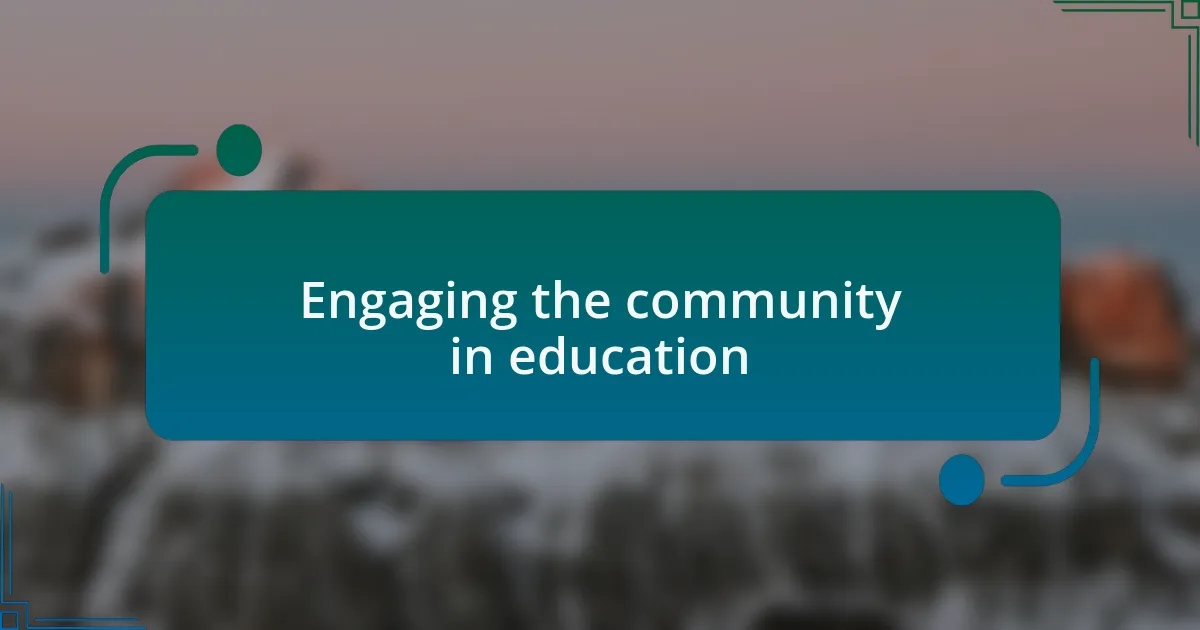
Engaging the community in education
Creating a bridge between education and community engagement is essential in fostering a collective sense of responsibility towards the environment. I recall a local workshop I facilitated where residents shared their experiences with waste management and sustainable gardening. The stories exchanged not only educated participants but also built strong connections, sparking collaborative projects that echoed long after the event ended. Have you ever felt that thrill when shared knowledge transforms into action?
To truly engage the community, I always strive to incorporate hands-on activities that make learning tangible. During a recent eco-fair, we set up interactive booths where families could create bird feeders from recycled materials. Watching children light up as they crafted something meaningful was a reminder of how interactive learning can instill lasting values. Doesn’t seeing the enthusiasm of young minds inspire us to create more engaging educational experiences?
Moreover, embracing local culture in educational events can make a profound impact. In one instance, I invited local artists to incorporate nature-themed art into our workshops, merging creativity with environmental awareness. This approach not only celebrated local talent but also allowed participants to express their ecological concerns in unique ways. Have you considered how blending art with education can enhance community engagement and inspire new perspectives?

Measuring impact of eco-events
Measuring the impact of eco-events is crucial for understanding their effectiveness and shaping future initiatives. After a local clean-up event, I conducted a simple survey to gauge participants’ feelings about their contribution. The results were illuminating; over 80% of respondents reported feeling more connected to their community and more aware of environmental issues. Have you ever wondered how just a few hours of collective effort can foster such strong feelings of empowerment?
Another method I’ve employed is tracking tangible outcomes, such as the amount of waste collected or native plants planted during events. At one tree-planting day, we planted over 500 saplings. Reflecting on that success, I couldn’t help but think about the potential impact those trees would have over the years. Doesn’t envisioning a lush future, thanks to our efforts today, motivate us to stay engaged?
I’ve also found that storytelling can be an effective tool for measuring impact. During a post-event gathering, I encouraged participants to share their experiences. Their heartfelt stories highlighted personal transformations, from adopting more sustainable practices to becoming vocal advocates for environmental change. Isn’t it fascinating how personal narratives can reveal the deeper effects of our eco-events, creating ripples in the community?
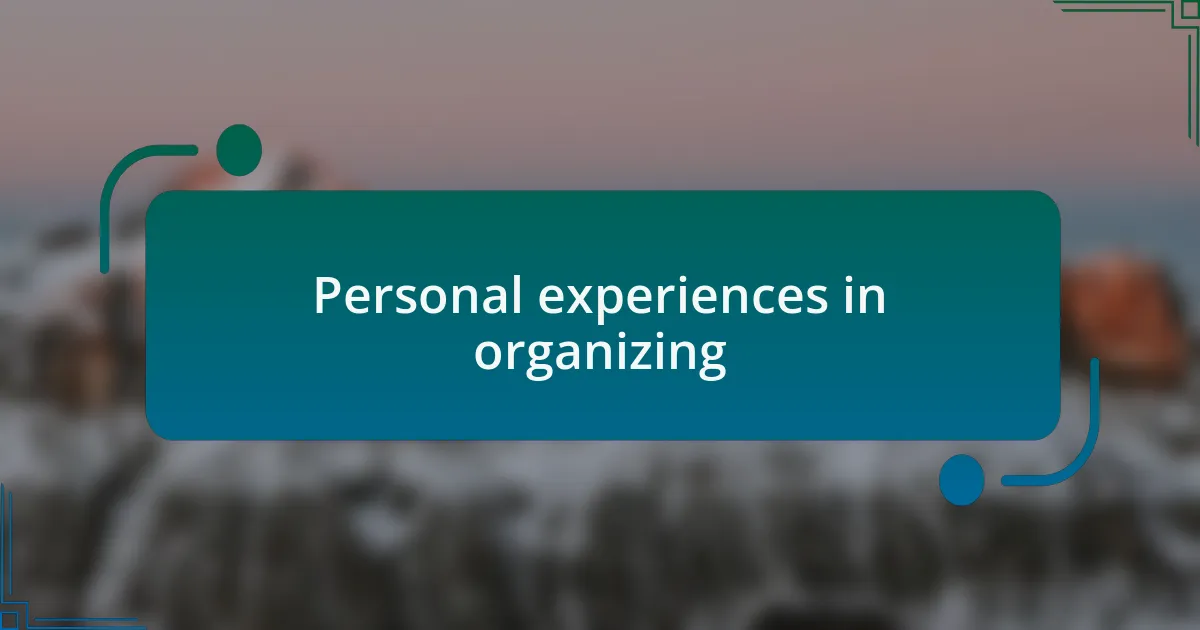
Personal experiences in organizing
When I first started organizing eco-events, I quickly discovered the importance of creating a welcoming atmosphere for participants. I remember one particular event where we held a community garden workshop. The initial nervousness of attendees melted away as we shared stories about our own gardening experiences. That connection set the stage for real learning and collaboration. Have you ever noticed how shared experiences can transform strangers into a community?
Another memorable experience was a beach cleanup I organized last summer. As we all gathered, I felt a surge of positivity. Seeing families, friends, and even solo volunteers unite for a common cause was energizing. During the event, I took a moment to pause and watch a little girl excitedly picking up litter while chatting with her mom about ocean creatures. That sight reminded me of the generational impact we can have through our efforts. How often do we get to witness moments that inspire future environmental stewards right before our eyes?
Moreover, I actively sought feedback after each event, and this practice has led to continuous improvement. During one follow-up, a participant suggested incorporating interactive activities like quizzes about local wildlife. I took that advice to heart, and the next event became a fun learning experience for everyone involved. Does it surprise you how small changes based on input can significantly enhance engagement and awareness?
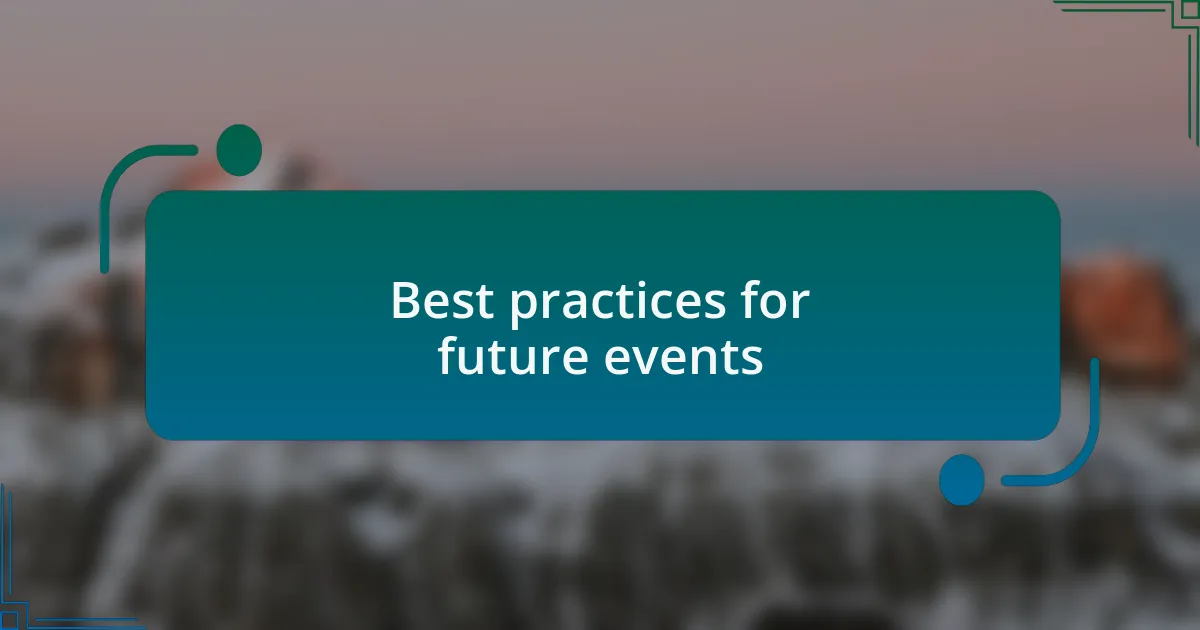
Best practices for future events
When planning future eco-events, I always emphasize the significance of clear communication. I once attended a sustainability fair where the schedule was confusing for attendees. People seemed lost, and it detracted from their experience. Since then, I’ve made it a point to provide detailed information beforehand, which I believe sets a positive tone and allows everyone to feel prepared. Have you ever arrived at an event unsure of what to expect?
Another key practice I’ve adopted is to involve local communities in the planning process. For instance, a neighborhood forum I organized brought together diverse voices, ensuring that the event resonated with local concerns. I felt the energy shift when residents saw their ideas reflected in our activities. It’s inspiring to witness how inclusivity can enhance both participation and ownership. What if every event became a platform for community expression?
Finally, I always prioritize sustainability in logistics. I learned this lesson after a particularly wasteful event with single-use materials. The effort to ensure eco-friendly resources not only reduces environmental impact but also communicates our commitment to the cause. I recall the positive response from attendees when we switched to biodegradable products. It made me realize that our choices can inspire others to embrace sustainable practices in their own lives. Have you ever seen how just one decision can ripple through a community?